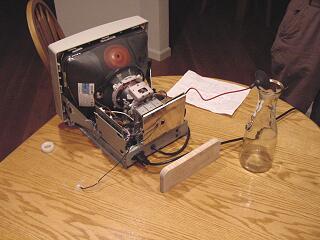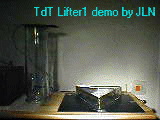
A Successful working Lifter1
by Ed Hutchins ( USA )

A Successful working
Lifter1
by
Ed Hutchins ( USA )
created on
February 17, 2002 - JLN Labs -
Last update February 17, 2002
All informations in this page are published free and
are intended for private/educational purposes and not for
commercial applications
|
||||||||||
Here's another one for your page:
I must say I was amazed at how totally simple it was to run this
experiment, thanks to the excellent information on your website.
- Ed Hutchins
Ed Hutchins' Lifter Experiments
Here are the results of our first experiments with recreating a lifer as described here.
I highly recommend trying this experiment (with the appropriate safety precautions). The key is to build the lifter as lightly as possible; initial experiments were hampered by the weight. I started by gluing together a balsa triangle and vertical corner posts with wood glue, then super-gluing tinfoil around the legs. The top conductor was made out of magnet wire glued into slots in the tops of the balsa posts. I failed to create a rounded-over edge to the tinfoil which I fixed after the fact with extra bits of foil and some tape, but the design would have been lighter had I left some foil extending above the top edge and then folded it over. If you fail to do this you'll get too much arcing to achieve flight. The power supply turned out to be super simple; I took an old monitor and just used the HV source at the side of the tube (usually covered in a big rubber protector on most monitors I've seen) and the ground wire from the strapping around the front of the monitor. The initial design had the top conductor too close to the tinfoil, which resulted in lots of arcing and no flight. I had to cut the posts in half and then use bits of plastic coffee-stirrer in order to adjust the height. Without too much messing around we managed to get the lifter to fly. One useful intermediate step was to suspend the lifter as a pendulum, which showed there was quite a bit of force being generated. Also, running the lifter with the lights off helps to find and eliminate places where a lot of coronal discharge or arcing is happening. Good luck!

This is the basic lifter and the power supply (an old KFC
14" color monitor we picked up from HSC for $9.95)
See also the :
 Lifters builders
and tests feed-back
Lifters builders
and tests feed-back ![]()
Return to the Lifters Builders page